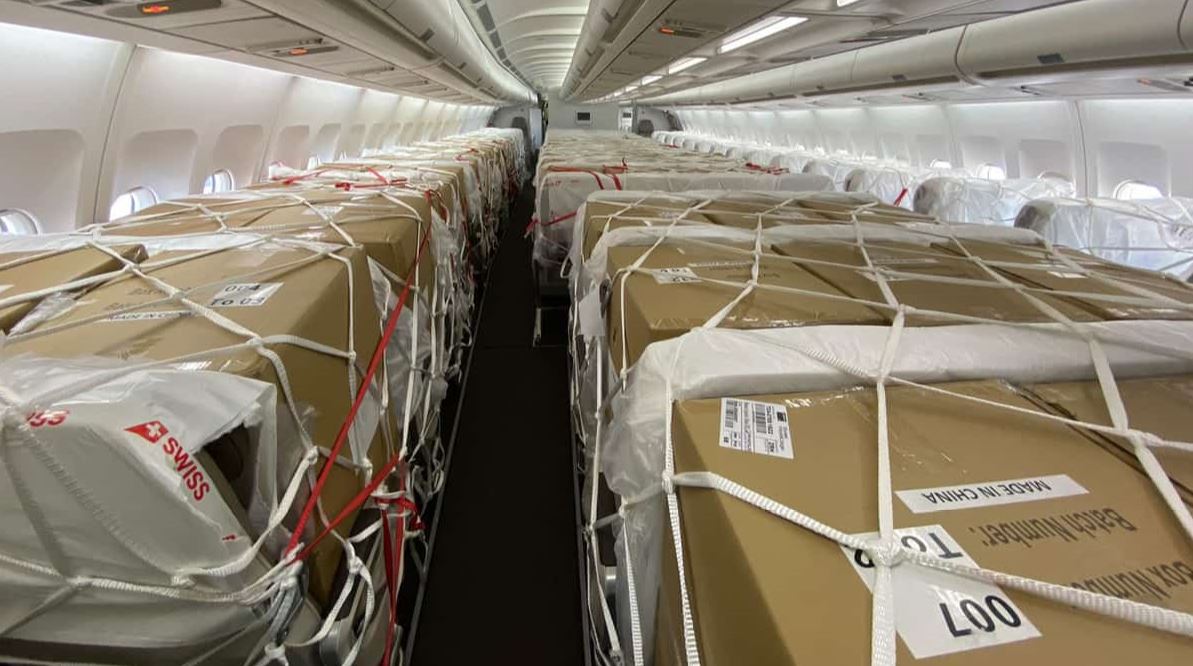The traditional cargo storing method by stuffing the loads into the airplane’s belly is certainly an easy task, but storing cargo in the passenger cabin is a whole different level of the task.
However, due to the huge economic blow to the aviation industry due to the outbreak of the Covid-19 virus, many of the passenger carriers saw innovative approaches to increase their cargo capacity. The passenger aircraft. Cargo-in-cabin innovation has remained popular for some airlines, fitting in the boxes of cargo in the passenger cabin. Many airlines switched part of their fleet to cargo operation during the pandemic. Some even removed the total passenger’s seat to make more space for the cargo.
The passenger aircraft dedicated purely to cargo operation has played a significant role in the pandemic period to deliver critically humanitarian and commercial supplies while generating income for the airlines that saw massive losses after the plummeting of the air travel demand.
Even the Emirates Airline has operated with more than 3,100 flights with cargo on the seat and in the overhead bins of its wide-bodied aircraft Boeing 777-300. The Dubai-based carrier transported more than 11,000 metric tons of cargo from May 2020.

For the conversion from passenger to cargo operator, many of the airlines used the bottom half of the airplanes to hold cargo which normally shares space with the baggage, whereas others opted out for adding extra capacity by storing light shipment in the passenger cabin or removing the passenger seat for full-floor loading.
Removable cargo containers with smoke detectors
Removable cargo containers are one of the most innovative approaches to increasing a passenger aircraft’s cargo capacity. The removable containers that can be installed within just 24 hours gave most of the aircraft’s a breather while dealing with the after effect of the Covid-19 pandemic. The Colibri Aero, a Lithuania-based aircraft part supplier and interior refurbishment, introduced the temporary removable containers that could help airlines to branch out their cargo sector as air travel demand pummeled way beyond the profit margins.
The temporary containers designed by the Colibri Aero allowed the airlines to carry cargo inside the passenger cabin of their wide-bodied aircraft like Airbus A330s, Airbus A340s, Boeing 767s, and Boeing 777s.
Aero’s temporary cargo containers are even certified by the European Aviation Safety Agency(EASA). The temporary cargo containers come in 5 different sizes to fit the specific designs of the aircraft to maximize the cargo holding spaces.

Each type of cargo container is integrated with the smoke detecting system and has the potential to hold a maximum of 850 kg of cargo. On a typical Airbus A330 passenger aircraft’s setup, the aircraft can fit 36 of the temporary cargo container in its passenger cabin, meaning that with the help of Aero’s strategic innovation, the aircraft can carry as much as 27 tonnes of cargo in a single flight without compromising the performance of the Airbus aircraft.
The Aero’s temporary cargo containers can be either used to turn the entire passenger cabin into a cargo-only space or with the configuration option of part-cargo containers. It doesn’t matter which option the airlines choose for their aircraft; the 24-hours installation and another 24 hours period for dismantling the temporary cargo cabins to re-install the passenger’s seats is certainly a new strategy that the carriers can implement even in the post-pandemic world. Aero’s cargo storing containers in the passenger’s cabin has opened up the aviation market for a new set of opportunities for the carriers operating with the limited number of aircraft, this technology allows the airlines to serve both passenger and cargo segments within the same week strategizing the level of demand in the market.
Also, the innovative technology that offers mixed market strategies for airlines is relatively cost-efficient and can aid the airlines’ economic growth. According to the Colibri Aero, the cost for turning a full passenger cabin into cargo spaces with removable cargo containers varies depending on the seat capacity and space of the aircraft, i.e., the price for converting a standard Airbus A330 cabin may cost between $1 million- $1.2 million. The cost includes container production cost, engineering as well as the supplemental type certificate cost; after the containers are ready, the airlines can use the containers as per their market strategy installing and dismantling the temporary containers at just the engineering costs after installation and certification during the first changeover as the cargo containers will be owned by the carriers.
Cabin cargo boxes
For the airlines that don’t want to step up for a complete installation of new containers in the passengers’ cabin area, the cabin cargo boxes have become a flexible solution. The swift cargo storage concept introduced amid the pandemic is the lightweight solution designed to boost the airline’s cargo capacity for the main jet cabin to its maximum level without the need of going through any conversion or modification to turn the passenger’s carrier into a freighter. The innovative strategy, launched by the German aerospace manufacturer EFW in July 2020, can hold up to 200 kg of cargo in a single cabin cargo box with a tare weight of 28 kg per container. By receiving a green signal from the EASA and getting awarded the Supplemental Type Certification(STC), the cabin cargo boxes innovation has already made a name for itself as the most convenient way of instituting the passenger aircraft into the cargo segment.

The standard, Airbus A330-200, when configured with the cabin cargo boxes in side-by-side principles of three containers per row, can nearly fit 19 tonnes of freight per flight; the freight capacity is the separate calculation from the belly luggage holdings of the wide-bodied jetliner.
In-seat package stowage system
Introduced by the Hong-Kong based aircraft engineering group, HAECO, the in-seat package stowage system doesn’t require the carriers to remove seats from passengers’ cabins in order to create more space for the cargo. The HAECO group was one of the first providers to launch the special in-seat stowage system that allows airlines to hold packages loaded with freight on the passengers’ seats, allowing the aircraft to carry more cargo during each flight.
The in-seat package stowage system was first launched with Alaska Airlines in December 2020; the carrier installed the in-seat package system on three of its wide-bodied Boeing 737-900 passenger jets that served the peak of cargo demand in the pandemic world. With this technology, the aircraft can carry 6,123 kg of freight in the passengers’ cabin, including the payload capacity of 7,484 kg in the belly holding space of the aircraft. As the technology is based on simple design, two cargo load agents are required to monitor the cargo spaces throughout the loading process, provide fire suppression if needed and make sure the cargos are safe and secure with the in-seat package stowage system.
The SeatBox
The seat box cargo holding system is another simple yet effective innovation that doesn’t require renovation of the aircraft’s space and seats. Designed by the Dubai-based MV Aviation, ‘The SeatBox’ is customized to carry cargo in any configuration inside the passenger cabin, including every class from Economy, Premium, Business, and even the First Class Cabin. The seat box cargo containers are made up of 100% recycled carboards, which is why this innovative approach is considered a progressive solution for holding cargo in the passenger cabin, replacing the use of plastic in the aviation industry. These seat boxes are made of Honeycomb cardboard from the sides, bottom, and top; meanwhile, the corner of the seat boxes are manufactured with high-density cardboards. For making the seat boxes holding cargo sturdy throughout the process, the corners connecting the top and bottom panels of the box are assembled with a special machine.
Further, the installation process of this cargo holding in passenger cabin technology is also pretty simple and just takes one minute for a complete setup. During the flight, the boxes are strapped with certified C172 straps to ensure their safety. One of the best things about this technology is that every seat box container is customized and designed with the specific need of the customers.








